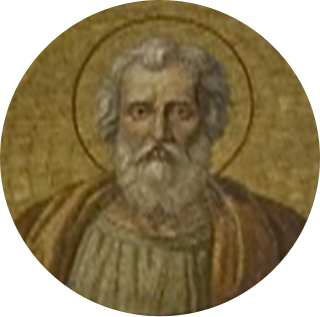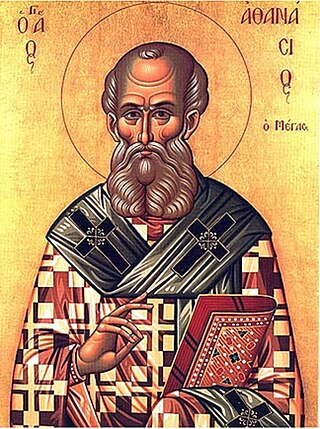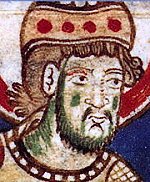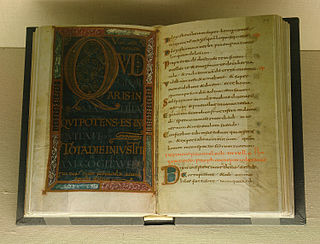
Heretic pope Felix, an archdeacon of Rome, was installed as Pope in 355 AD after the Emperor Constantius II banished the reigning Pope, Liberius, for refusing to subscribe to a sentence of condemnation against Saint Athanasius.

Athanasius I of Alexandria, also called Athanasius the Great, Athanasius the Confessor, or, among Coptic Christians, Athanasius the Apostolic, was a Christian theologian and the 20th patriarch of Alexandria. His intermittent episcopacy spanned 45 years, of which over 17 encompassed five exiles, when he was replaced on the order of four different Roman emperors. Athanasius was a Church Father, the chief defender of Trinitarianism against Arianism, and a noted Egyptian Christian leader of the fourth century.

Pope Damasus I, known as Damasus of Rome, was the bishop of Rome from October 366 to his death. He presided over the Council of Rome of 382 that determined the canon or official list of sacred scripture. He spoke out against major heresies, thus solidifying the faith of the Catholic Church, and encouraged production of the Vulgate Bible with his support for Jerome. He helped reconcile the relations between the Church of Rome and the Church of Antioch, and encouraged the veneration of martyrs.

Pope Julius I was the bishop of Rome from 6 February 337 to his death on 12 April 352. He is notable for asserting the authority of the pope over the Arian Eastern bishops, as well as setting December 25 as the official birthdate of Jesus.

The Vulgate, sometimes referred to as the Latin Vulgate, is a late-4th-century Latin translation of the Bible.
The 350s decade ran from January 1, 350, to December 31, 359.
Year 352 (CCCLII) was a leap year starting on Wednesday of the Julian calendar. At the time, it was known as the Year of the Consulship of Decentius and Paulus. The denomination 352 for this year has been used since the early medieval period, when the Anno Domini calendar era became the prevalent method in Europe for naming years.
Pope Liberius was the bishop of Rome from 17 May 352 until his death. According to the Catalogus Liberianus, he was consecrated on 22 May as the successor to Julius I. He is not mentioned as a saint in the Roman Martyrology. That makes him the earliest pontiff not to be venerated as a saint in the Catholic Church and, along with Anastasius II, one of only two popes to be omitted from Catholic sainthood in the first 500 years of church history.

Hilary of Poitiers was Bishop of Poitiers and a Doctor of the Church. He was sometimes referred to as the "Hammer of the Arians" and the "Athanasius of the West". His name comes from the Latin word for happy or cheerful. In addition to his important work as bishop, Hilary was married and the father of Abra of Poitiers, a nun and saint who became known for her charity.
Ursicinus, also known as Ursinus, was elected pope in a violently contested election in 366 as a rival to Pope Damasus I. He ruled in Rome for several months in 366–367, was afterwards declared antipope, and died after 381.

Eusebius of Vercelli was a bishop from Sardinia and is counted a saint. Along with Athanasius, he affirmed the divinity of Jesus against Arianism.
Semi-Arianism was a position regarding the relationship between God the Father and the Son of God, adopted by some 4th-century Christians. Though the doctrine modified the teachings of Arianism, it still rejected the doctrine that Father, Son, and Holy Spirit are co-eternal, and of the same substance, or consubstantial, and was therefore considered to be heretical by many contemporary Christians.

Lucifer of Cagliari was a bishop of Cagliari in Sardinia known for his passionate opposition to Arianism. He is venerated as a Saint in Sardinia, though his status remains controversial.
Saturninus of Arles was a Gallo-Roman Arian bishop of Arles in the early 4th century who under Constantius II was Primate of Gaul. He is known for his opposition to Saint Hilary of Poitiers, bishop of Poitiers, at the Church Council of Arles of 353.

There exist a number of translations of the Book of Psalms into the Latin language. They are a resource used in the Liturgy of the Hours and other forms of the canonical hours in the Latin liturgical rites of the Catholic Church.
The Pneumatomachi, also known as Macedonians or Semi-Arians in Constantinople and the Tropici in Alexandria, were an anti-Nicene Creed sect which flourished in the regions adjacent to the Hellespont during the latter half of the fourth, and the beginning of the fifth centuries. They denied the godhood of the Holy Ghost, hence the Greek name Pneumatomachi or 'Combators against the Spirit'.

Constantine the Great's (272–337) relationship with the four Bishops of Rome during his reign is an important component of the history of the Papacy, and more generally the history of the Catholic Church.
The Synod of Milan or Council of Milan may refer to any of several synods which occurred in late Roman Mediolanum or medieval Milan in northern Italy's Po valley:

Dionysius was bishop of Milan from 349 to 355. He is honoured as a Saint in the Catholic and Eastern Orthodox Churches and his feast day is 25 May.
Potamius, also known as Potamius of Lisbon, was the first recorded bishop of the city of Lisbon. He was possibly born in Lisbon, given that Iberian communities at the time usually chose their own citizens as bishops. He was part of the Council of Sirmium in 357, in which he defended Arianism. He is the second earliest Christian prose writer of the Iberian Peninsula, with Hosius of Corduba being the first.











